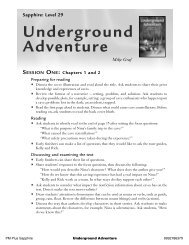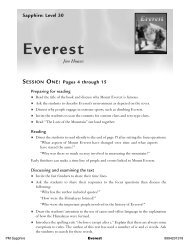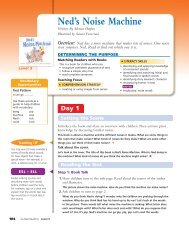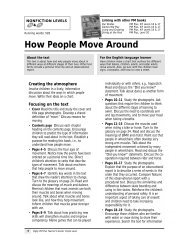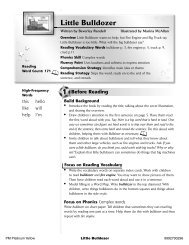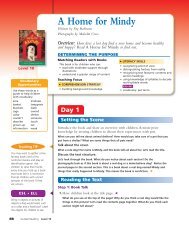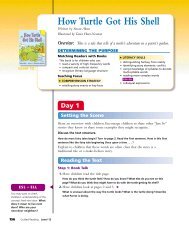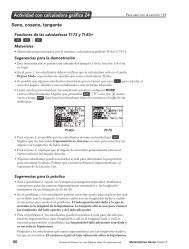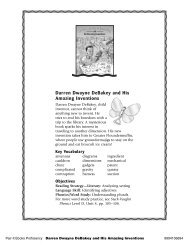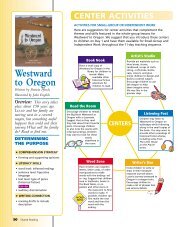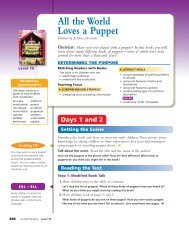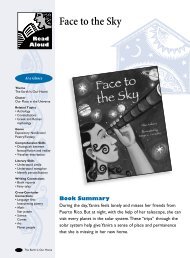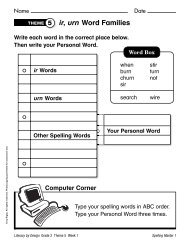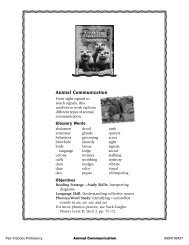Realistic fiction The Real McCoy – Rigby
Realistic fiction The Real McCoy – Rigby
Realistic fiction The Real McCoy – Rigby
You also want an ePaper? Increase the reach of your titles
YUMPU automatically turns print PDFs into web optimized ePapers that Google loves.
<strong><strong>Real</strong>istic</strong> <strong>fiction</strong><br />
Links to the theme<br />
You Don’t Say!<br />
Additional Resources<br />
Pages 15, 31, 35, 41, 55<br />
Pages 21<strong>–</strong>23<br />
F<br />
50 Fiction, Grade 4<br />
<strong>The</strong> <strong>Real</strong> <strong>McCoy</strong><br />
by Susan McCloskey<br />
Overview<br />
This realistic <strong>fiction</strong> book tells the story of Devin <strong>McCoy</strong>, who<br />
volunteers to spend his summer helping Mom and Gram rescue<br />
a failing business. But Devin’s good intentions sometimes backfire,<br />
causing Gram’s Diner to lose money. How does Devin redeem<br />
himself ?<br />
Teaching Focus<br />
★ COMPREHENSION STRATEGY<br />
Synthesizing:<br />
Retelling in order to clarify<br />
Vocabulary Opportunities<br />
advertise (p. 8)<br />
incident (p. 18)<br />
replenished (p. 24)<br />
discouraged (p. 32)<br />
rummage (p. 38)<br />
secure (p. 41)<br />
anxiously (p. 44)<br />
solemnly (p. 47)<br />
poring over (p. 54)<br />
profit (p. 87)<br />
Suggested Trade Titles<br />
Blume, Judy. Tales of a Fourth Grade<br />
Nothing. Dell Publishing Co., 1991.<br />
Costain, Meredith. Errol the Peril.<br />
<strong>Rigby</strong>, 1995.<br />
Konigsberg, E. L. Jennifer, Hecate,<br />
Macbeth, William McKinley, and Me,<br />
Elizabeth. Yearling Books, 1985.<br />
★ LITERACY SKILLS<br />
• Distinguishing types of genre<br />
• Identifying character<br />
• Identifying author’s style of writing<br />
• Distinguishing fantasy from reality<br />
•Identifying diphthongs<br />
Individual Needs<br />
•understanding colloquialisms, dialect,<br />
idioms, and slang<br />
Park, Barbara. Skinnybones. Random<br />
House, 1997.<br />
Smith, Robert Kimmel. <strong>The</strong> War With<br />
Grandpa. Yearling Books, 1984.<br />
Spinelli, Jerry. Fourth Grade Rats.<br />
Scholastic, 1996.
Day 1<br />
1<br />
Setting the Scene<br />
Using your best judgment, adapt the<br />
following to meet the needs of each<br />
group.<br />
1. To introduce the topic, have students<br />
listen as you read aloud the<br />
synopsis from the back cover.<br />
Have you ever made a big mistake when<br />
trying to help your parents? What happened?<br />
How did you feel about yourself?<br />
Did you eventually have a chance<br />
to prove that you were responsible?<br />
2. Introduce the book by showing<br />
the cover illustration. Have students<br />
describe the setting. Encourage<br />
them to predict why Devin might<br />
be alone on the dock.<strong>The</strong>n read<br />
the title aloud.<br />
Have you ever heard this expression?<br />
How might it relate to the story?<br />
Have students write down their<br />
predictions for future reference.<br />
3. Discuss elements of realistic <strong>fiction</strong>.<br />
(See pages T36 and T37.) Ask<br />
students to think of books they<br />
have read that have <strong>fiction</strong>al characters<br />
who behave as people do<br />
in real life.<br />
4. Review the comprehension strategy,<br />
synthesizing, with students.<br />
Focus on the importance of being<br />
able to retell what you have read.<br />
Encourage students to think about<br />
what is essential to include in a<br />
summary or a retelling.<br />
Model a think-aloud Illustrate<br />
this strategy by reading Chapter 1<br />
aloud.<strong>The</strong>n model a retelling of<br />
Chapter 1.<br />
This is what has happened so far: Devin<br />
reacts to a “mean kid.” Gram offers<br />
advice, but the encounters between<br />
Devin and “the mean kid” don’t<br />
improve. Devin worries that he made<br />
a big mistake by coming to Maine.<br />
Reading the Text<br />
Chapters 1<strong>–</strong>3 (pages 1<strong>–</strong>18)<br />
Below Grade Level Readers<br />
1. Have students reread Chapter 1<br />
with a partner.Ask each student to<br />
select key events that should be<br />
included in a chapter summary.<br />
Discuss the chapter.<br />
Why do Devin and the “mean kid”<br />
avoid eye contact? Is it a problem for<br />
Devin that he is not very daring?<br />
Explain. Did Gram give Devin good<br />
advice? Why or why not? Devin thinks<br />
he made a big mistake. Do you agree?<br />
2. Read Chapter 2 aloud. Remind<br />
students to listen for key events<br />
that may be used in a summary of<br />
the chapter. Stop at the break on<br />
page 8 and ask students to write<br />
predictions about how Devin’s life<br />
might change.<br />
3. Continue reading the remainder of<br />
Chapter 2 to students as they follow<br />
along in their own copies.<strong>The</strong>n<br />
have them state key events from<br />
the chapter and retell what has happened<br />
so far. Discuss the chapter by<br />
using open-ended questions.<br />
What might the expression “the real<br />
<strong>McCoy</strong>” mean? How could changing<br />
the menu help Gram’s Diner? How<br />
could it hurt? How is John’s advice<br />
about making friends helpful?<br />
4. Have students read Chapter 3 with<br />
a partner. Remind them that they<br />
are to select key events to include<br />
Talk about local restaurants<br />
and diners. Discuss<br />
job titles and responsibilities<br />
of the people who<br />
work there. Compare<br />
and contrast various<br />
restaurant menus.<br />
Use a map to show<br />
students the location of<br />
Maine and New York.<br />
Discuss the definitions of<br />
rural, urban, and suburban.<br />
Compare and contrast<br />
these settings.<br />
A vocabulary notebook<br />
may be helpful for students<br />
to keep track of<br />
new words they learn in<br />
this story.<br />
You can create a classroom<br />
chart of literary<br />
terms with definitions so<br />
students can use them<br />
when discussing the<br />
book (include conflict,<br />
resolution, character<br />
traits, dialogue, narration,<br />
setting, foreshadowing,<br />
imagery, and so on).<br />
<strong>The</strong> author uses phrases<br />
that cannot be understood<br />
in a literal sense.<br />
You may need to explain<br />
idioms such as to take up<br />
the slack (p. 6).<br />
If students mention<br />
details when retelling,<br />
explain the difference<br />
between a key event and<br />
a detail.<br />
<strong>The</strong> <strong>Real</strong> <strong>McCoy</strong> 51 F
<strong>The</strong> word gobsmacked<br />
(p. 14) is a slang word.<br />
Explain this word to students<br />
by replacing it with<br />
a word that may have<br />
more meaning to them.<br />
Invite students to use<br />
gobsmacked in a sentence.<br />
Indicate the author’s use<br />
of foreshadowing on<br />
page 3: …his experience<br />
with the unfriendly kid<br />
made him wonder if he<br />
had made a big mistake.<br />
Encourage students to<br />
look for other examples<br />
of foreshadowing as the<br />
book progresses.<br />
An additional example of<br />
foreshadowing can be<br />
found on page 8:<br />
Hearing their voices,<br />
Devin knew that something<br />
was in the air. Ask<br />
students what they think<br />
this might mean.<br />
✔Assessment<br />
Observe and informally<br />
assess students as they<br />
read, asking individuals<br />
to quietly read aloud a<br />
portion of the text.<br />
F<br />
52 Fiction, Grade 4<br />
in a brief retelling of the day’s<br />
reading. Discuss the chapter’s key<br />
events. Ask students to give their<br />
rationale for identifying specific<br />
events as noteworthy. ✔<br />
Why would Mom want Devin to be<br />
more “outgoing”?<br />
On Grade Level Readers<br />
1. Have students reread Chapter 1.<br />
<strong>The</strong>n discuss key events.<br />
What do we learn about Devin’s character<br />
based on his reaction to the “mean<br />
kid”? How do you think things might<br />
have been different if Devin had spoken<br />
up? If Devin finds his own fishing<br />
spot, do you think this problem will be<br />
solved or do you think he’ll continue to<br />
have conflicts with the “mean kid”?<br />
2. Have students read Chapter 2.<br />
Remind them to select key events<br />
for a retelling. After reading<br />
Chapter 2, have students jot down<br />
their predictions about how<br />
Devin’s life might change.<strong>The</strong>n<br />
discuss the chapter.<br />
What does the expression “the real<br />
<strong>McCoy</strong>” mean? Even though Gram’s<br />
approach to running a diner may be old<br />
fashioned, why would her style entice<br />
the people in Blue Harbor to visit her<br />
restaurant often?<br />
3. Have students read Chapter 3.<br />
Remind them to select key events<br />
to include in a retelling of the<br />
day’s reading. ✔<br />
4. Discuss Chapter 3’s key events. Ask<br />
students to provide their rationale<br />
for identifying specific events as<br />
noteworthy.<br />
Why is Mom concerned about leaving<br />
Devin at the pier this year? Why does<br />
Mom point out the kids to Devin?<br />
Above Grade Level Readers<br />
1. Review Chapter 1 with students.<br />
Encourage them to refer back to<br />
the text to help them discuss key<br />
events.<br />
How else could Devin have reacted to<br />
the “mean kid’s” claim of ownership?<br />
Do you think this one incident is enough<br />
to cause Devin to doubt his decision, or<br />
could there be other factors involved?<br />
2. Have students read Chapter 2.<br />
Remind them to select key events<br />
for a retelling. After reading<br />
Chapter 2, have students jot down<br />
their predictions about how<br />
Devin’s life might change.<strong>The</strong>n<br />
discuss the chapter.<br />
What does the expression “the real<br />
<strong>McCoy</strong>” mean? What are Gram’s<br />
motives for keeping the restaurant the<br />
way it is? How might Mom and Dad’s<br />
approach to running a business be<br />
threatening to Gram?<br />
3. Have students read Chapter 3<br />
individually. Remind them to<br />
select key events to include in a<br />
retelling of the day’s reading. ✔<br />
4. Discuss Chapter 3’s key events. Ask<br />
students to provide their rationale<br />
for identifying specific events as<br />
noteworthy.<br />
What is Mom’s motive for telling Devin<br />
about the kids on the pier? How does<br />
Devin try to live up to her expectations?<br />
How is Devin like the “mean kid”?<br />
Returning to the Text<br />
All Groups<br />
1. Discuss the first three chapters.<br />
What character traits does Devin have?<br />
How has the author helped you to<br />
get to know Devin? How do Devin’s
encounters with the “mean kid” support<br />
what we already know about<br />
him? Would Devin be a friend of yours?<br />
Explain.<br />
2. Discuss the genre and how elements<br />
of this story fit that genre.<br />
How does the author’s use of dialogue<br />
fit the genre? How does the use of<br />
slang add to the realism of the story?<br />
How does the setting in Chapter 1 differ<br />
from that in Chapter 2? How are<br />
they both realistic?<br />
3. Depending on students’ success<br />
with the book, address one or<br />
more of the following teaching<br />
points each day during the fiveday<br />
teaching sequence.<br />
★ COMPREHENSION STRATEGY<br />
★ Synthesizing: Retelling in order<br />
to clarify Ask students to express<br />
the benefits of retelling a story by<br />
engaging them in a discussion.<br />
How does retelling refresh your memory<br />
of what happened in a story? How<br />
does it help you focus on key events?<br />
How do you use the elements in a<br />
story (such as setting, characters, plot)<br />
to help you retell it?<br />
Invite students to begin filling in a<br />
Story Elements Chart (See the<br />
<strong>Rigby</strong> Literacy Graphic Organizer<br />
Book,p.15).<strong>The</strong>y can add to their<br />
charts as they progress through the<br />
book. At the completion of the<br />
book, ask volunteers to use their<br />
charts to retell the story, focusing<br />
on key events and main characters.<br />
★ LITERACY SKILLS<br />
★ Distinguishing types of genre<br />
Review the characteristics of realistic<br />
<strong>fiction</strong>. Discuss the setting and<br />
characters. How are they realistic?<br />
Talk about the dialogue used<br />
throughout the book. How does<br />
it give readers insight about the<br />
characters’ personalities?<br />
★ Identifying character Present<br />
students with the definitions for<br />
“main” character and “minor”<br />
character. Can they identify the<br />
main characters and the minor<br />
characters in <strong>The</strong> <strong>Real</strong> <strong>McCoy</strong>?<br />
Have them justify their answers.<br />
<strong>The</strong>n ask students to find evidence<br />
in the text that describes these<br />
characters.<br />
★ Identifying author’s style of<br />
writing Point out how the author’s<br />
style (which incorporates figurative<br />
language, modern dialogue,<br />
imagery, and so on) makes <strong>The</strong><br />
<strong>Real</strong> <strong>McCoy</strong> realistic and entertaining.<br />
Can students find examples of<br />
the author’s literary style as they<br />
read? Which elements of this<br />
author’s style might students want<br />
to incorporate in their own writing?<br />
★ Distinguishing fantasy from<br />
reality Read aloud from the<br />
bottom of page 12 (“So it’ll be just<br />
me and Mom…”) to the end of<br />
page 13.<strong>The</strong>n engage students in a<br />
discussion about Devin’s one-sided<br />
conversation with Squeezie.<br />
Did you expect Squeezie to respond to<br />
Devin’s inquiry about the future? Why<br />
or why not? In your opinion, could the<br />
author have added a fantasy element<br />
to the story by having Squeezie<br />
respond? Would the story still be considered<br />
realistic <strong>fiction</strong>?<br />
★ Identifying diphthongs <strong>The</strong><br />
diphthongs ou and ow, as pronounced<br />
in the words out and cow,<br />
<strong>The</strong> <strong>Real</strong> <strong>McCoy</strong> 53 F
You may want to model<br />
a retelling of the first<br />
three chapters in order to<br />
help students review the<br />
key events.<br />
Remind students to look<br />
for context clues to define<br />
unfamiliar words and<br />
phrases, such as watch<br />
caps on pages 19 and 20.<br />
If necessary, briefly discuss<br />
the first half of<br />
Chapter 5 with students.<br />
Focus on Devin’s problem<br />
of talking to others on<br />
the dock.<br />
Throughout the text, the<br />
author includes examples<br />
of onomatopoeia, such<br />
as plunk (p. 27). Make<br />
sure students know that<br />
onomatopoeia means the<br />
sound of a word echoes<br />
the word’s meaning.<br />
Can students find other<br />
examples?<br />
✔Assessment<br />
Observe and informally<br />
assess students as they<br />
read, asking individuals<br />
to quietly read aloud a<br />
portion of the text.<br />
F<br />
54 Fiction, Grade 4<br />
represent a combination of two<br />
sounds. <strong>The</strong> <strong>Real</strong> <strong>McCoy</strong> contains a<br />
number of words containing these<br />
diphthongs: hourglass (p. 4), mouthed<br />
(p. 5), doubtful (p. 6), outgoing (p. 11),<br />
roughhousing (p. 15), crowded (p. 16),<br />
Gloucester (p. 20), flowers (p. 25),<br />
frown (p. 29), whereabouts (p. 48),<br />
allowed (p. 51), and hounds (p. 85).<br />
Invite students to find words containing<br />
the diphthongs ou and ow<br />
as they read <strong>The</strong> <strong>Real</strong> <strong>McCoy</strong>. Can<br />
they find examples of these diphthongs<br />
in their own writing?<br />
Responding to the Text<br />
See activities listed on Day 5.<strong>The</strong>se<br />
may be used on any day throughout<br />
the five-day teaching sequence.<br />
Day 2<br />
Reading the Text<br />
Chapters 4<strong>–</strong>6 (pages 19<strong>–</strong>36)<br />
Below Grade Level Readers<br />
1. Briefly review key events in<br />
Chapters 1<strong>–</strong>3.<br />
2. Read Chapter 4 aloud and then<br />
discuss the key point (Mom and<br />
Gram have differing opinions<br />
about the menu).<br />
Why does Gram think the diner’s menu<br />
should offer simple foods rather than<br />
fancy foods?<br />
3. Have student pairs read Chapter 5<br />
through the third paragraph on<br />
page 29. Ask them to predict why<br />
the diner might be closed.<br />
4. Have students finish reading<br />
Chapter 5 with their partners.<br />
How does Devin punish himself when<br />
he discovered he turned off the freezer?<br />
Have you ever felt like Devin? Why<br />
do you think Devin took his stuffed<br />
python to bed?<br />
5. Have students read Chapter 6 with<br />
a partner and retell events in the<br />
chapter. ✔<br />
Why does Devin sometimes wish he<br />
never came to Maine? How does Devin<br />
feel when the “mean kid” passes by?<br />
Why? Why would Gram admire the<br />
“mean kid’s” behavior on the pier?<br />
On Grade Level Readers<br />
1. Have students read Chapter 4<br />
individually or with a partner. As<br />
they read, invite them to notice<br />
details about Gram’s Diner.<strong>The</strong>n<br />
have volunteers retell what happened<br />
in this chapter.<br />
Mom wants to add fancy things to the<br />
menu, but Gram argues with her. What<br />
do you think of Gram’s response to<br />
Mom’s suggestion? Why does Devin<br />
feel obligated to help at the diner?<br />
2. Ask students to note Chapter 5’s<br />
title and make a prediction.<strong>The</strong>n<br />
have them read Chapter 5 individually<br />
or with a partner. Students<br />
can check their predictions and<br />
discuss the characters’ reactions to<br />
the mishap.<br />
Gram and Mom have a half smile, half<br />
frown on their faces (p. 29). How does<br />
this facial expression reveal their<br />
mood? Why doesn’t Mom scold Devin?<br />
How will he scold himself instead?<br />
3. Have students read Chapter 6 individually<br />
or with a partner.After<br />
retelling, discuss Devin’s feelings. ✔
Why does Devin seem lonelier now<br />
than before? What makes Gram think<br />
the “mean kid” might be Danny Costa?<br />
Above Grade Level Readers<br />
1. Have students read Chapter 4.<br />
After a volunteer retells what happens<br />
in the chapter, discuss new<br />
details students learned about<br />
Gram’s Diner.<br />
How do you think Gram’s regular customers<br />
are reacting to Mom’s menu<br />
changes? Why does Devin feel obligated<br />
to help Mom and Gram? What does<br />
this reveal about his character?<br />
2. Have students read Chapter 5.Ask<br />
them to note Chapter 5’s title and<br />
make a prediction. Have students<br />
check their predictions and discuss<br />
the effects of the mishap on Devin.<br />
Devin’s inner dialogue reveals a conflict<br />
(p. 28). Have you ever felt like Devin?<br />
Explain. Why is Devin so disheartened<br />
by his shyness? How does the mishap<br />
further upset Devin?<br />
3. Have students read Chapter 6<br />
individually or with a partner.<br />
Have a volunteer do a retelling of<br />
the day’s reading.<strong>The</strong>n discuss<br />
Chapter 6. ✔<br />
Why does Devin hide his feelings from<br />
Gram? Why does Devin seem lonelier<br />
now than before? Why is Devin convinced<br />
he will never have any friends<br />
in Blue Harbor?<br />
Returning to the Text<br />
All Groups<br />
1. Have students participate in creating<br />
a Character Traits Web of<br />
Devin. (See the <strong>Rigby</strong> Literacy<br />
Graphic Organizer Book, page 31.)<br />
What character traits does Devin have?<br />
What have we learned about Devin<br />
through his thoughts and behavior?<br />
Justify your responses using specific<br />
examples from the story.<br />
2. Depending on students’ success<br />
with the book, address one or<br />
more of the teaching points listed<br />
on Day 1. Use these teaching<br />
points as appropriate during the<br />
five-day teaching sequence.<br />
Responding to the Text<br />
See activities listed on Day 5.<strong>The</strong>se<br />
may be used on any day throughout<br />
the five-day teaching sequence.<br />
Day 3<br />
Reading the Text<br />
Chapters 7<strong>–</strong>10 (pages 37<strong>–</strong>60)<br />
Below Grade Level Readers<br />
1. Ask volunteers to state the key<br />
events in Chapters 4<strong>–</strong>6.<br />
2. Model a think-aloud As you<br />
read Chapter 7, help students<br />
identify key events. Pause at the<br />
break on page 39.<br />
In this chapter, Devin is still worrying<br />
about approaching the “mean kid.”<br />
<strong>The</strong>n I read that Devin finds a knife,<br />
but he’s too shy to ask the boy if he<br />
lost something. Finally, Devin forces<br />
himself to speak to the “mean kid.”<br />
Continue to read to the bottom of<br />
page 43.Ask students to predict<br />
what might happen next.<strong>The</strong>n<br />
have them read the rest of the<br />
chapter and check their predictions.<br />
Explain the meaning of<br />
thinking himself into a<br />
box, (p. 37). How does<br />
Devin jump to conclusions?<br />
Cite examples.<br />
✔Assessment<br />
Observe and informally<br />
assess students as they<br />
read, asking individuals<br />
to quietly read aloud a<br />
portion of the text.<br />
<strong>The</strong> <strong>Real</strong> <strong>McCoy</strong> 55 F
Use a map to show students<br />
where Siberia is.<br />
Explain why Devin thinks<br />
he’ll be exiled.<br />
<strong>The</strong> author’s use of<br />
“diner lingo” adds a realistic<br />
flair to the story.<br />
Discuss how this and the<br />
author’s use of modern<br />
dialogue suits realistic<br />
<strong>fiction</strong> as a genre.<br />
Throughout the story,<br />
“diner lingo” is defined<br />
in context. Have students<br />
look for context clues as<br />
they come across this<br />
lingo.<br />
Devin considers himself<br />
both a hero and a villain<br />
in this chapter. Talk about<br />
how these labels fit him.<br />
Have students stop at the<br />
break on p. 57 and discuss<br />
how Devin’s character<br />
is changing.<br />
✔Assessment<br />
Observe and informally<br />
assess students as they<br />
read, asking individuals<br />
to quietly read aloud a<br />
portion of the text.<br />
F<br />
56 Fiction, Grade 4<br />
3. Have students read Chapter 8 with<br />
a partner. <strong>The</strong>n discuss the disappearance<br />
of Squeezie.<br />
Why would a python on the loose<br />
cause the diner to close? What makes<br />
Devin think it will take weeks to find<br />
Squeezie? Why is family approval so<br />
important to Devin?<br />
4. Have students read Chapter 9 with<br />
a partner.Ask them to make a prediction<br />
based on the title.After they<br />
check predictions and retell key<br />
events, discuss the chapter. ✔<br />
How does Devin prove he really is<br />
courageous? How is Devin feeling<br />
about himself at the end of this chapter?<br />
Do you think two shy kids will be<br />
able to run a booth?<br />
5. Read aloud Chapter 10 as students<br />
follow along. Encourage them to<br />
think about how Devin’s character<br />
is changing.<br />
Why is it important for Gram’s Diner<br />
to have a booth at the Festival? How<br />
has Devin changed? Find examples in<br />
the text that illustrate this change.<br />
How is Devin’s opinion of Blue Harbor<br />
changing?<br />
On Grade Level Readers<br />
1. Have a volunteer briefly review<br />
key events in Chapters 4<strong>–</strong>6.<br />
2. Before students read Chapter 7,<br />
have them predict what will be<br />
lost and found. A volunteer can<br />
retell the key events after reading.<br />
Devin is disappointed in himself. Why?<br />
How does he resolve this conflict? Why<br />
doesn’t Devin mention the earlier incident<br />
at the pier? What was lost in this<br />
chapter? found? What remains to be<br />
found?<br />
3. Invite students to read Chapter 8<br />
with a partner. After retelling, discuss<br />
the lost python.<br />
What problems could have occurred<br />
had the diner remained open with a<br />
python on the loose? How is Devin<br />
guilty of “thinking himself into a box”<br />
again? Why is Devin reluctant to hear<br />
his parents’ telephone conversation?<br />
4. Have students read Chapter 9.<br />
How does Devin prove his bravery?<br />
How has Devin changed in this chapter?<br />
Instead of thinking about having<br />
fun, Devin sees the Lobster Festival as<br />
a way to save the diner. What does this<br />
say about him?<br />
5. Have students read Chapter 10 on<br />
their own. ✔<br />
Why is Devin trying to attract kids to<br />
the booth? Why does Devin want the<br />
ice-cream caper to be kept secret from<br />
Mom? What does this say about his<br />
self-confidence? his compassion?<br />
Above Grade Level Readers<br />
1. Invite students to make a prediction<br />
based on Chapter 7’s title.<br />
Have them read Chapter 7,<br />
checking their predictions.<br />
Devin is very disappointed in himself.<br />
How does he resolve this disappointment?<br />
Why didn’t Devin mention the<br />
earlier incident with Danny at the pier?<br />
Gram admits the “last thing [she wants]<br />
is a python on the loose” (p. 41). How<br />
might this be an example of foreshadowing?<br />
2. Have students read Chapter 8.<br />
How is Devin guilty of “thinking himself<br />
into a box” again? Why is Devin<br />
reluctant to hear his parents’ telephone<br />
conversation? Why is Gram’s answer to<br />
Devin’s request on page 47 solemn?
3. Ask students to read Chapter 9. As<br />
they read, encourage them to look<br />
for evidence that Devin’s character<br />
may be changing.<br />
How does Devin prove his bravery? <strong>The</strong><br />
key is symbolic of a turning point in<br />
the story. How has Devin changed since<br />
turning that key? What do you think of<br />
Devin’s idea for a booth at the Lobster<br />
Festival?<br />
4. Have students read Chapter 10 on<br />
their own. ✔<br />
What makes Devin think his vanilla ice<br />
cream will be extraordinary? Why does<br />
Devin want the ice-cream caper to be a<br />
secret? What does this plan reveal<br />
about how he is changing?<br />
Returning to the Text<br />
All Groups<br />
1. Students can discuss how Devin’s<br />
self-confidence is beginning to<br />
improve.<br />
In what ways has Devin changed in the<br />
last three chapters? Find specific examples<br />
from the story.<br />
2. Depending on students’ success<br />
with the book, address one or<br />
more of the teaching points listed<br />
on Day 1. Use these teaching<br />
points as appropriate during the<br />
five-day teaching sequence.<br />
Responding to the Text<br />
See activities listed on Day 5.<strong>The</strong>se<br />
may be used on any day throughout<br />
the five-day teaching sequence.<br />
Day 4 Discuss symbolism in literature.<br />
Can students<br />
think of examples from<br />
Reading the Text<br />
Chapters 11<strong>–</strong>14 (pages 61<strong>–</strong>83)<br />
Below Grade Level Readers<br />
1. Read page 61 to the middle of<br />
page 63.<br />
Mrs. Costa realizes the boys are in for a<br />
lot of work, and she volunteers to help<br />
them. I wonder if this will ensure the<br />
success of their ice-cream caper.<br />
Ask students what effect they<br />
think Mrs. Costa’s help will have<br />
on the boys’ success.<br />
2. Have students continue reading<br />
Chapter 11 with a partner.<br />
How does the diner lingo fit the foods<br />
mentioned in this chapter?<br />
3. Invite students to read Chapter 12<br />
with a partner.<br />
What important lesson did the boys<br />
learn in the early stages of making ice<br />
cream?<br />
4. Read page 69 through the fourth<br />
paragraph on page 71 in Chapter<br />
13 to students. Have them predict<br />
how Danny will respond to<br />
Devin’s questioning about their<br />
first encounter.<strong>The</strong>n have students<br />
finish Chapter 13 with a partner.<br />
Were you surprised by Danny’s reaction<br />
to Devin’s questioning? Why or why<br />
not? Predict the boys’ success at the<br />
festival. Does Chapter 14’s title provide<br />
a clue to their success?<br />
5. Have students read the first three<br />
paragraphs of Chapter 14 on page<br />
75. Ask them to predict how<br />
Devin will react to Mom’s news.<br />
other literary works they<br />
have read?<br />
Have students stop at<br />
the break on p. 57 and<br />
discuss how Devin’s<br />
character is changing.<br />
Mrs. Costa uses diner<br />
lingo to describe supper.<br />
Ask students to predict<br />
what it means.<br />
✔Assessment<br />
Observe and informally<br />
assess students as they<br />
read, asking individuals<br />
to quietly read aloud a<br />
portion of the text.<br />
<strong>The</strong> <strong>Real</strong> <strong>McCoy</strong> 57 F
Attire (p. 76) is defined in<br />
context. Remind students<br />
to look for context clues<br />
when they come across<br />
unfamiliar words.<br />
Have students pause<br />
after reading the fourth<br />
paragraph on p. 71 and<br />
predict Danny’s reaction<br />
to Devin’s questioning.<br />
✔Assessment<br />
Observe and informally<br />
assess students as they<br />
read, asking individuals<br />
to quietly read aloud a<br />
portion of the text.<br />
F<br />
58 Fiction, Grade 4<br />
Have students finish reading the<br />
chapter and then discuss. ✔<br />
Why doesn’t Devin let his shyness get<br />
in the way of getting his booth back?<br />
What might Mr. Gomez mean when he<br />
says that Devin’s ice cream is “the real<br />
<strong>McCoy</strong>”?<br />
On Grade Level Readers<br />
1. Have students read Chapter 11<br />
with a partner. Ask them to identify<br />
the key events in the chapter.<br />
Why does the author tell us about<br />
Danny’s job of holding the yarn? How<br />
does this information affect Devin’s<br />
feelings about himself?<br />
2. Invite students to read Chapters 12<br />
and 13. A volunteer can retell what<br />
happened in these chapters.<br />
How did Devin and Danny misread<br />
each other? What have they learned?<br />
Danny tells Devin that when something<br />
really matters, he will be brave enough<br />
to defend it. Predict what might happen<br />
in the next chapter.<br />
3. Have students read Chapter 14. A<br />
volunteer can retell the chapter<br />
events. ✔<br />
Devin refrains from “thinking himself<br />
into a box.” Explain what happens, and<br />
what it reveals about Devin’s character.<br />
What might Mr. Gomez mean when he<br />
says that Devin’s ice cream is “the real<br />
<strong>McCoy</strong>”?<br />
Above Grade Level Readers<br />
1. Ask students to read Chapters 11<br />
and 12. Have a volunteer retell key<br />
events.<strong>The</strong>n discuss the chapter.<br />
How does the diner lingo add a realistic<br />
touch to this story? Are the events and<br />
characters’ behaviors realistic in these<br />
two chapters? Explain.<br />
2. Invite students to read Chapter 13.<br />
Encourage them to be aware of any<br />
changes in Devin’s character.<br />
How did Devin and Danny misread<br />
each other? What have they learned?<br />
How does the saying, “You shouldn’t<br />
judge a book by its cover” apply here?<br />
Danny tells Devin that when something<br />
really matters, he will be brave enough<br />
to defend it. How might this foreshadow<br />
something to come in the next<br />
chapter?<br />
3. Have students read Chapter 14,<br />
noting evidence that Devin’s character<br />
is gaining self-confidence. ✔<br />
Danny seemed to know that Devin<br />
would be courageous enough to<br />
defend what was important to him. At<br />
this point in the story, how might<br />
Devin agree with Gram’s perspective,<br />
that Danny was to be admired for<br />
defending his fishing spot? What might<br />
Mr. Gomez mean when he says that<br />
Devin’s ice cream is “the real <strong>McCoy</strong>”?<br />
Returning to the Text<br />
All Groups<br />
1. Engage students in a discussion<br />
about the boys’ friendship.<br />
How is Devin’s friendship with Danny<br />
leading to changes in how he thinks<br />
and behaves? Would you evaluate<br />
Danny’s influence on Devin—as<br />
positive or negative? Why?<br />
2. Students can discuss how Devin’s<br />
self-confidence is improving.<br />
In what ways has Devin changed in the<br />
last four chapters? Cite specific examples<br />
from the text that show how<br />
Devin is growing up.
3. Depending on students’ success<br />
with the book, address one or<br />
more of the teaching points listed<br />
on Day 1. Use these teaching<br />
points as appropriate during the<br />
five-day teaching sequence.<br />
Responding to the Text<br />
See activities listed on Day 5.<strong>The</strong>se<br />
may be used on any day throughout<br />
the five-day teaching sequence.<br />
Day 5<br />
Reading the Text<br />
Chapters 15<strong>–</strong>19 (pages 84<strong>–</strong>106)<br />
Below Grade Level Readers<br />
1. Read Chapter 15, stopping at the<br />
break on page 86.<br />
Model a think-aloud Identify<br />
key events for a retelling.<br />
Devin’s homemade ice cream was a big<br />
success. <strong>The</strong>y sold all of it, and even<br />
sooner than they thought. It seems<br />
they are pleasantly surprised at the<br />
profit they made.<br />
2. Have students read the rest of<br />
Chapter 15 with a partner.<br />
What do you think Mom and Dad<br />
talked about on the phone? How might<br />
Devin’s idea affect the diner’s future?<br />
What is Mom’s definition of “the real<br />
<strong>McCoy</strong>”? How did your prediction from<br />
Chapter 2 compare with her definition?<br />
3. Have students read Chapter 16<br />
with a partner.<br />
What is the meaning of the chapter<br />
title? How does the phrase, “the real<br />
<strong>McCoy</strong>” suit Devin’s ice cream? What is<br />
Devin hoping for now? Judging from<br />
Chapter 17’s title, predict whether his<br />
wish will come true.<br />
4. Read Chapter 17 to students.<br />
How is Devin about to play the role of<br />
hero again? Do you think Devin is acting<br />
in a realistic way by suggesting<br />
that Mrs. Costa work for nothing?<br />
Explain your thoughts.<br />
5. Invite students to read Chapter 18<br />
with a partner. ✔<br />
Why does Danny’s mom agree to work<br />
at Gram’s Diner? How is Gram’s Diner<br />
like Devin’s ice cream?<br />
6. Read Chapter 19 with students.<br />
Pause after the second full paragraph<br />
on page 103 and discuss<br />
how Devin must be feeling at this<br />
point in the story.<br />
Are you surprised by the crowd at the<br />
diner? by the popularity of Devin’s ice<br />
cream? Why or why not?<br />
Finish reading the chapter with<br />
students.<br />
How does Gram’s Diner menu reflect<br />
the chapter’s title?<br />
On Grade Level Readers<br />
1. Read Chapter 15, stopping at the<br />
break on page 86. Engage students<br />
in a think-aloud as they identify<br />
key events for a retelling.<br />
2. Invite students to read the rest of<br />
Chapter 15.<br />
Do you think the boys have earned<br />
enough to get the diner out of debt?<br />
Why or why not?<br />
3. Have students read Chapter 16.<br />
How does the phrase, “the real <strong>McCoy</strong>”<br />
suit Devin’s ice cream? Where did that<br />
expression come from? What is Devin<br />
Ask students to apply the<br />
phrase, “the real <strong>McCoy</strong>”<br />
to things that are genuine<br />
and not imitations.<br />
Have students predict<br />
what is in the package<br />
on page 97.<br />
Have students predict<br />
what the surprise is on<br />
page 99.<br />
Have students think back<br />
to their original predictions<br />
from Chapter 2<br />
about the meaning of<br />
“the real <strong>McCoy</strong>.” How<br />
does their prediction<br />
compare with Mom’s<br />
definition (p. 87)?<br />
✔Assessment<br />
Observe and informally<br />
assess students as they<br />
read, asking individuals<br />
to quietly read aloud a<br />
portion of the text.<br />
<strong>The</strong> <strong>Real</strong> <strong>McCoy</strong> 59 F
Have students stop at<br />
the break on page 94<br />
and make a prediction.<br />
What might happen<br />
next?<br />
Have students predict<br />
what is in the package<br />
on page 97.<br />
Have students predict<br />
what the surprise is on<br />
page 99.<br />
Have students think back<br />
to their original predictions<br />
from Chapter 2<br />
about the meaning of<br />
“the real <strong>McCoy</strong>.” How<br />
does their prediction<br />
compare with Mom’s<br />
definition (p. 87)?<br />
You may want to discuss<br />
the theme You Don’t<br />
Say! Ask students how<br />
this book fits into the<br />
theme.<br />
✔Assessment<br />
Observe and informally<br />
assess students as they<br />
read, asking individuals<br />
to quietly read aloud a<br />
portion of the text.<br />
F<br />
60 Fiction, Grade 4<br />
hoping for now? Judging from Chapter<br />
17’s title, do you think his wish will<br />
come true? What might happen next?<br />
4. Ask students to read Chapter 17.A<br />
volunteer can retell key events for<br />
the group. Check predictions and<br />
then discuss the chapter.<br />
How does the author’s use of foreshadowing<br />
help you predict what might<br />
happen? Why does Mom think she<br />
must close Gram’s Diner? How might<br />
Devin be living up to his role of<br />
hero again?<br />
5. Have students read Chapter 18.<br />
A volunteer can retell key<br />
events.<br />
What did you think was in the package?<br />
Why? How might the book help<br />
Gram’s Diner stay in business?<br />
6. Have students read Chapter 19.<br />
After checking predictions and<br />
retelling, discuss the chapter. ✔<br />
Devin has grown taller, but is the<br />
change in Devin just physical? How else<br />
has Devin grown over the summer in<br />
Maine? What matters most to Devin<br />
right now? What does this say about<br />
his character?<br />
Above Grade Level Readers<br />
1. Have students read Chapter 15.<br />
Both Mom and Gram think Devin’s ice<br />
cream was a big hit. How do you think<br />
Devin’s success makes him feel?<br />
2. Invite students to read Chapter 16.<br />
How does the phrase, “the real <strong>McCoy</strong>”<br />
suit Devin’s ice cream? Where did that<br />
expression come from? What is Devin<br />
hoping for now? Judging from Chapter<br />
17’s title, do you think his wish will<br />
come true?<br />
3. Have students read Chapters 17<br />
and 18. A volunteer can retell key<br />
events.<br />
How did the author’s use of foreshadowing<br />
on page 94 help you predict<br />
what would happen? Identify the problem<br />
on page 95. How did Devin resolve<br />
it? Was his solution a realistic one?<br />
Explain. Which menu would suit a diner<br />
considered to be “the real <strong>McCoy</strong>”—an<br />
old-fashioned menu, or a modern one?<br />
Why?<br />
4. Ask students to read Chapter 19.<br />
<strong>The</strong>n discuss the chapter. ✔<br />
How has Devin grown over the summer?<br />
How do you think Devin felt<br />
when his family walked into the busy<br />
diner? Have you ever felt that way?<br />
Explain.<br />
Returning to the Text<br />
All Groups<br />
1. On page 12, Devin thinks about<br />
his brother’s baseball team, and<br />
how much the team relies on<br />
John. On page 99, Devin wonders<br />
whether his brother feels like he<br />
let the team down, as John’s injury<br />
will keep him from playing baseball.<br />
Have students reread both<br />
sections of the text. Discuss why<br />
Devin thinks John would feel like<br />
he let the team down.<br />
How might Devin feel if he were in<br />
John’s place? Would Devin’s character,<br />
as portrayed at the beginning of the<br />
story, have a different reaction than<br />
Devin’s character as portrayed at the<br />
end? How?
2. Have students read the second and<br />
third full paragraphs on page 105.<br />
What really matters to Devin at the<br />
end of this story? How have his character<br />
traits changed over the course of<br />
the summer?<br />
3. Depending on students’ success<br />
with the book, address one or<br />
more of the teaching points listed<br />
on Day 1. Use these teaching<br />
point as appropriate during the<br />
five-day teaching sequence.<br />
Responding to the Text<br />
Optional independent or smallgroup<br />
response activities are listed<br />
below.<br />
Reread the book. Invite students<br />
to reread a portion of <strong>The</strong> <strong>Real</strong><br />
<strong>McCoy</strong>.<strong>The</strong>y may reread a chapter<br />
or two that show the biggest<br />
changes in Devin.<strong>The</strong>y can also<br />
listen to the CDs that accompany<br />
this book.<br />
✔Write about the book Invite<br />
students to write about <strong>The</strong> <strong>Real</strong><br />
<strong>McCoy</strong> in their reading logs, or<br />
have them choose an activity listed<br />
below. You may also encourage<br />
students to suggest their own writing<br />
projects related to the book.<br />
Below Grade Level Readers<br />
• Students can complete a Fact or<br />
Opinion Chart about Squeezie the<br />
python. (See the <strong>Rigby</strong> Literacy<br />
Graphic Organizer Book, page 55.)<br />
What facts and opinions can they<br />
gather from <strong>The</strong> <strong>Real</strong> <strong>McCoy</strong> and<br />
other sources? What opinions can<br />
they gather from conducting a survey<br />
of classmates’ feelings about<br />
having a python as a pet?<br />
• Invite students to create a menu of<br />
dishes that they might serve at<br />
their own diner.What diner lingo<br />
would they assign to each item?<br />
On Grade Level Readers<br />
• Throughout <strong>The</strong> <strong>Real</strong> <strong>McCoy</strong>,<br />
Devin <strong>McCoy</strong> changes. Have students<br />
find examples of his character<br />
trait changes and complete a<br />
Character Change Story Map. (See<br />
the <strong>Rigby</strong> Literacy Graphic Organizer<br />
Book, page 35.) Encourage students<br />
to explore how the character<br />
has grown physically and emotionally<br />
over his summer in Maine.<br />
• Have students write a few paragraphs<br />
about Devin’s shyness and<br />
his tendency to “think himself into<br />
a box” (jump to conclusions). How<br />
did this cause a big misunderstanding<br />
between Devin and Danny?<br />
When does the turning point<br />
occur? What is the outcome?<br />
Above Grade Level Readers<br />
• <strong>The</strong> author includes examples of<br />
foreshadowing in <strong>The</strong> <strong>Real</strong> <strong>McCoy</strong>.<br />
Have students write their own<br />
definitions of this literary term.<br />
<strong>The</strong>n have them cite examples<br />
of foreshadowing from the story.<br />
How did foreshadowing help<br />
students make predictions?<br />
• At the end of each chapter, students<br />
can complete a Problems-<br />
Solutions Chart to list Devin’s<br />
problems and how they were<br />
resolved. (See the <strong>Rigby</strong> Literacy<br />
Graphic Organizer Book, page 41.)<br />
<strong>The</strong>n have students sum up how<br />
these problems lead Devin to grow<br />
as a character.<br />
✔Assessment<br />
Also, see the Features of<br />
Fiction Assessment on<br />
pages 21<strong>–</strong>23 of the<br />
Reading Workshop<br />
Blackline Master<br />
Assessment Book.<br />
When you reread a<br />
classic, you do not see<br />
more in the literature<br />
than you did before;<br />
you see more in<br />
yourself than there<br />
was before.<br />
—Clifton Fadiman<br />
<strong>The</strong> <strong>Real</strong> <strong>McCoy</strong> 61 F



